The sun was still asleep when St. Joseph’s Indian School students and staff rose on a chilly November morning. The grass was covered in frosted crystals, and breath from the group exhaled as clouds into the cool autumn air.
They had all risen early for one special purpose: for it was the day of the buffalo harvest.
“You guys ready?” hollered LaRayne, Native American Studies teacher, from the driver’s seat of the bus after everyone had taken their seats.
“Let’s go!” shouted one of the eighth grade students.
And with a cough and drowsy rumble from the engine, the group set off toward Lower Brule, S.D., where two Native American elders of the Kul Wicasa Oyate tribe (Lower Brule Sioux tribe) would be waiting for them.
As the long stretches of prairie passed along the highway, the students sat quietly in their seats. Although there had been much commotion and conversation before the bus departed campus, somehow the quiet of the outside had made its way in — a hushed anticipation filled the air.
The prairie was a blank canvas of yellow grasses, dotted only by dark specks of cattle and bare trees. As a rusty orange and red sunrise broke free from the horizon, other animals began announcing themselves with the start of the new day. Wild turkeys, horses and deer were present along the bumpy, winding roads, but the animal students were most excited to see on this special day, superior among the rest: the tȟatȟáŋka — buffalo.
Arriving in Kul Wicasa Oyate
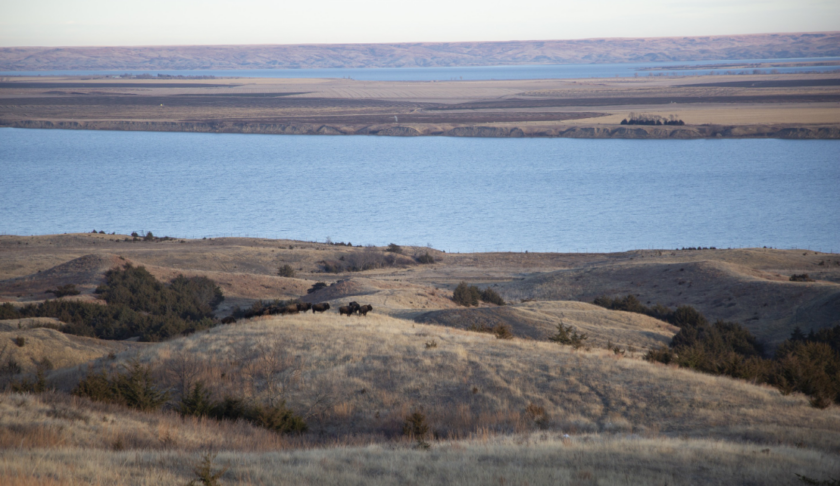
As the group arrived, the first stop was at the Tribal Offices to get acquainted with the elders and wildlife officials facilitating the day.
“Mitákuyepi!” said Alvin Grassrope, one of the elders. “That’s our Lakota way of greeting you — of saying good morning, my relatives.”
The students responded, but went quiet to listen to how the day was going to play out. This was to be a first time experience for all of them.
“What you are going to witness,” said Alvin, “is such a wonderful thing. He [the buffalo] is going to sacrifice himself for you … now that is a very, very powerful thing.”

Dewayne Goodface, the second elder and one of the last fluent Lakota speakers, agreed and addressed the students.
“I am very glad to have you here. I hope you learn something so that you may pass on your experience to others,” he said.
Students again boarded the bus until arriving at the location near the buffalo herd, where a male buffalo would sacrifice himself for the benefit of St. Joseph’s students and their families.
As the hunters got into position, students and remaining staff joined together in a circle of prayer atop a hill overlooking the river valley. Everyone was given the opportunity of purification during azilya — otherwise known as smudging — by prayerfully wafting smoke from burning sage toward their bodies.
“Great Spirit, we pray for open ears and hearts today,” prayed LaRayne. “We pray our students will carry these lessons with them for the rest of their lives.”
Others around the circle took turns saying what they hoped the day would bring to them. Students and staff listed understanding, spirituality and connection.
“I hope I learn something that I can pass on to others,” said one eighth grade student, Sheryea.
The Ultimate Sacrifice
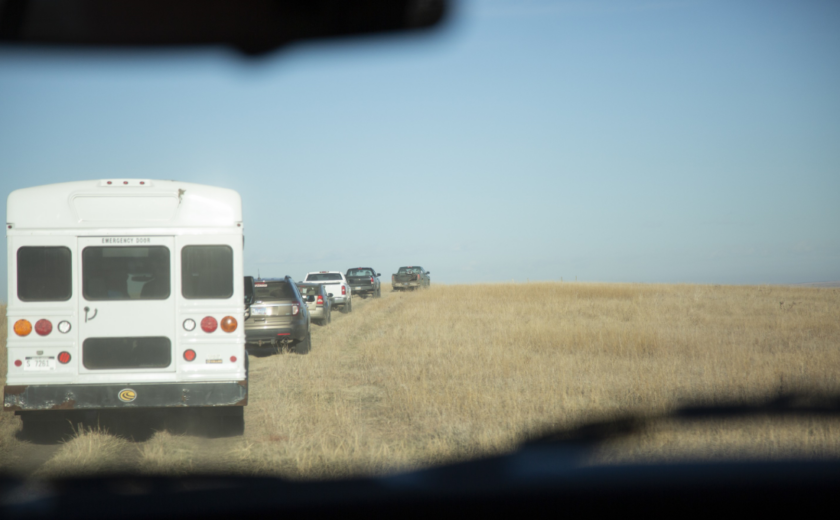
The hunters and elders determined the location of the herd in Lower Brule would be problematic, as the bus would be unable to travel to the spot of sacrifice. A secondary plan went into motion taking the group to Kennebec, S.D., approximately 15 miles west to another buffalo herd more easily accessible.
Students watched from a distance as the trucks carrying the elders and hunters closed in on the herd. Soon, a popping sound of a gun cracked the stillness of the prairie.
“When I heard the gunshot I was sad, but thankful for the sacrifice. It was a great experience for me,” said Neleigh, one of the eighth grade students.

The tȟatȟáŋka — buffalo — is a symbol of self-sacrifice; it gives until there is nothing left. And this young buffalo perished for the betterment of others, his relatives.
Students joined the rest of the group and stood in a circle around the brave buffalo. As the adults began dressing the animal, they were able to view and learn about the parts of the buffalo, each having a special and specific purpose.
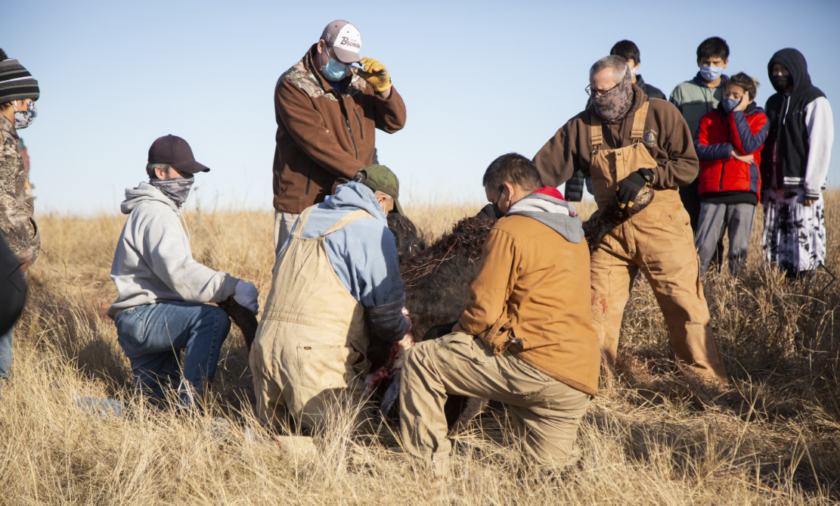
Joe, Mission Integration Director, said during this time of silence and amazement, the students and staff members were connecting their own spiritual lives to the buffalo.
“Students saw their ancestors in this buffalo,” he said. “They saw sacrifice for the love of others.”
And with that came an immense amount of appreciation from the students.
“I was thankful for the buffalo who gave his life to us,” said Richard, an eighth grade student.
Using All the Parts of the Buffalo
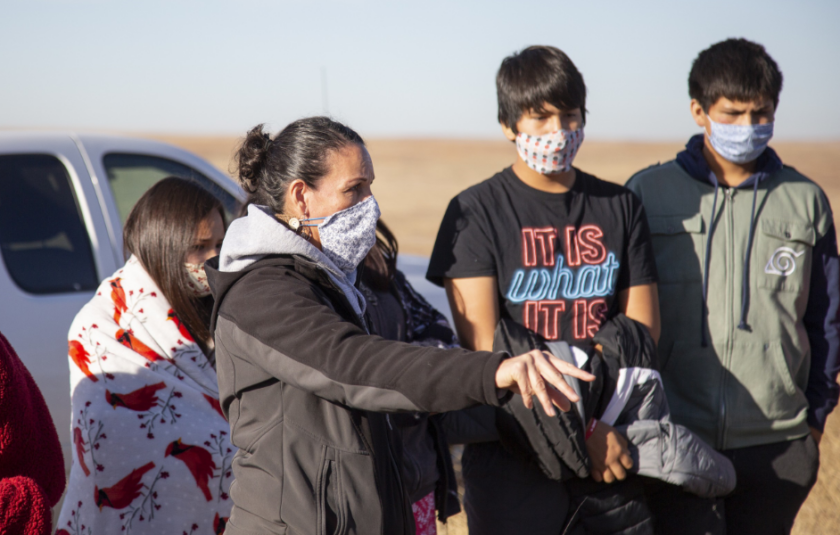
Historically, the buffalo provided for every need the Lakota people had by way of sheltering them with its hide over their tipis, covering their bodies as clothing and their feet as moccasins. Other parts of the buffalo created utensils such as needle and thread, cups, bowls and more.
And this buffalo truly sacrificed its life for the blessing of St. Joseph’s Indian School.
Like the students’ ancestors would have done, St. Joseph’s planned to make use of nearly all the parts of the buffalo following the sacrifice. The buffalo hide will be displayed in the Native American Studies classroom to remind younger students of something to look forward to when they become eighth graders. The skull will be kept and used during purification and ceremonies on campus.
None of the meat from the buffalo will be wasted. As students were taken to the Aktá Lakota Museum for extended learning from the elders about the buffalo, the buffalo was taken to a processing facility where the meat was made into buffalo sticks (similar to jerky). The sticks were given to all parents and guardians as they returned their children back to St. Joseph’s following winter break. Other portions of the buffalo were turned into ground meat, which will be used to cook family meals in St. Joseph’s homes and the dining hall.
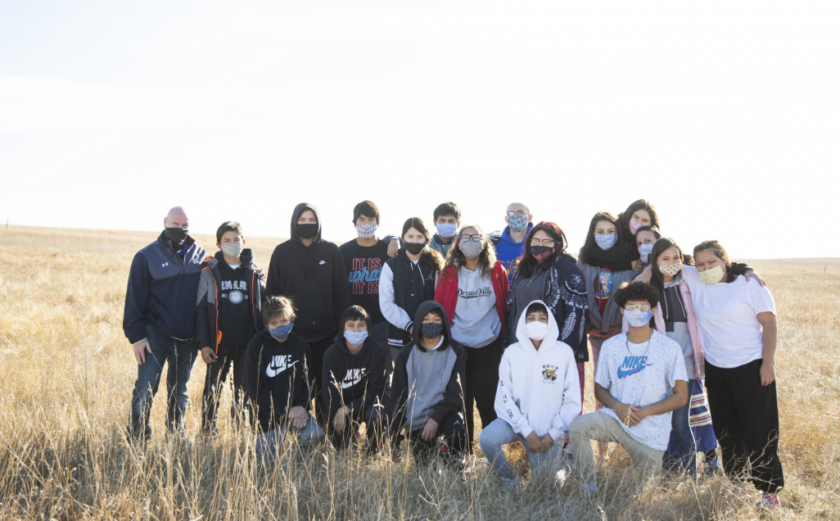 “The opportunity to feed our students, as well as their families during what’s been a very difficult season for many, is a tremendous blessing,” said Joe.
“The opportunity to feed our students, as well as their families during what’s been a very difficult season for many, is a tremendous blessing,” said Joe.
Sacrifice Comes Full Circle
And, although many suns have set since the day of the buffalo hunt, the blessings from it continues. As more homes and students sit down together for meals, the buffalo will again be what brings them together — what binds them …
“We like buffalo and have used the meat already in our home to make a buffalo stew and a casserole,” said Rich, a houseparent. “Suffice it to say, we had no leftovers. The girls — all of us — enjoyed it very much. Tara (the other houseparent and Rich’s wife) and I got the last little bit in the pan when they were done and shared it.”
Showing gratitude with meals and moments like these are what tie the whole experience together.
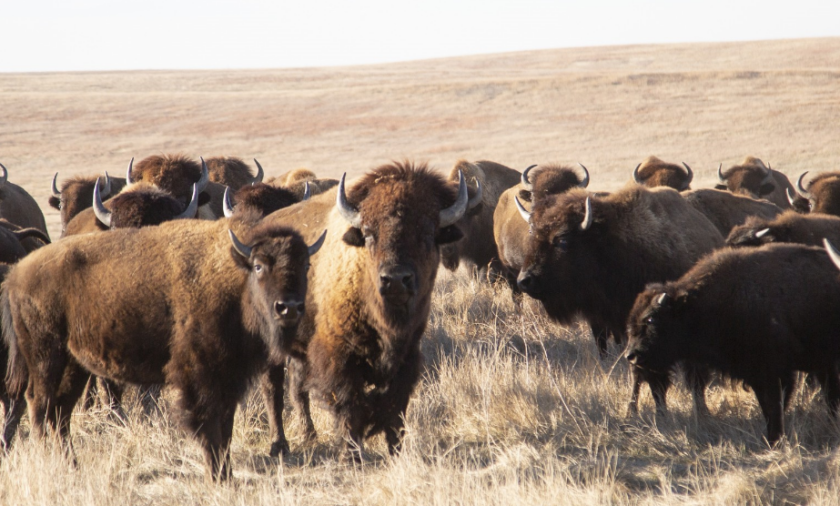
Wóphila tȟáŋka— many thanks — to all staff members, outside agencies, tribal members and elders who made this cultural experience a reality for St. Joseph’s Indian School students. Also, a thank you to generous supporters around the world. Cultural opportunities such as this are possible thanks to your wačháŋtognaka — generosity.
Learn more about the Lakota culture by visiting stjo.org/culture.


GodPureSpirit Is the Oneness Who continues Creation and Who Is our ultimate End and Meaning. This terrible coronavirus — not Willed by God but permitted is another great cleansing in our journey. Let us all be OPEN to God that we may all RECEIVE again another new beginning toward our Ultimate Goal ONE. The buffalo are our relatives as all animals are. It is in JesusChristGOD that God Is Working.
Thank you for sharing this experience of the Buffalo and the 8th graders. You are doing great work with the children so that they can learn about their heritage and we can as well. God bless you.
Hi, I’m enjoying the teachings on this page for how you have spiritual experience with the buffalo.
Thank you for sharing this beautiful story!!
Your story really made an impression on me. The life given by the Buffalo was truly an act of love wasn’t it? The Buffalo gave his life to save the Indian families by giving them food to eat which will give them a long and healthy life. Much like the way Jesus gave his life to those who believe in him by offering everlasting life. This story can serve all of us as a reminder to think of others’ needs and to be there to help if we are able.
I enjoyed this testimony to the ‘Buffalo’ very much and it was produced in excellent fashion to the Native American tribes. It reminded me of a painting my late wife and I bought in Colorado. It’s called ‘The Sacred
Circle’. The artist is Bev Doolittle. It depicts many kinds of wildlife forming into a circle and ties a Native American Indian on a horse in the center. We all come ‘Full Circle’ in our understanding of our Lord’s creatures
on Earth. It is nice that the Buffalo is our Nations animal. Thank you.
What a GRAND Event!!! To all who made this happen for these young people I admire your effort so very much. That the old ways are honored and that these young people can learn about them is priceless.
Thank you for sharing this special even with those of us so far from your world in person but not in spirit!
Sincerely, tt
It was exceptional to look into the life of the children you are nourishing in so many ways. I am glad you are teaching your students their native language and traditions. I pray for your leaders and the children and their families.
I learned from the buffalo hunt posting. Like the sacrifice of the buffalo, the Sioux leaders also sacrificed for others. This is an important lesson. God bless them and the school for what they did for the students. with that life lesson.
“Sacrificing itself for others”?? Oh, please. I don’t see anything in the article about the buffalo being asked whether or not he wanted to be killed. I’m a long-time supporter of the school, but I’m disappointed to learn that they are teaching the children to celebrate killing animals.
Hi Candace, the asking for a sacrifice of a buffalo is a sacred ceremony not to be taken lightly and is not simply an act of celebration in the killing on an animal. It goes much deeper than that. You can read more about the buffalo and what it means to the Lakota culture here, if you are interested: https://www.stjo.org/native-american-culture/important-animals/buffalo-tatanka/
Read about the Australian aboriginals who give thanks to the animal for sacrificing itself for the nourishment of the two- leggeds.
What a wonderful experience for not only these children, but also for their families and for people like myself, my mother was Cherokee, reading about their venture.
God’s Peace and Love to St. Joseph’s and all the wonderful teachers, leaders and personnel that care about the safety, education and future of our youth, I am so proud to be a donor…
Me encanto poder aprender sobre la cultura y tradicciones de las tribus indigenas de norteamerica.
GRACIAS
This was fascinating. Please explain what triggered the buffalo herd to begin separating into groups eventually leaving 1 buffalo as sacrifice?
Then was the gun shot to kill that one animal remaining for all?
How encouraging to read John Farren’s comment about seeing the sickness and troubles of our time as a cleansing through which God will work a greater good.
I truly enjoyed reading about the Buffalo hunt. It’s a wonderful method of teaching children about their heritage.
I have been supporting St. Joseph’s Indian School for quite some time and although I don’t really have much to give I do send a few dollars from my grocery money. I wish I could do more and I have a couple of ideas of how I can pick up things to send to the school to help out. I believe in the school’s mission and I would like to help more. Thank you for being there for the children you serve.
What a beautiful story. I pray all children can have such an amazing experience and understand how we share creation and all animals are a gift from God. Bless you!!
I enjoyed reading this story of the buffalo hunt. It was very informative. And I’m glad the children are being immersed in their culture. This is very important to me as a donor – to know the Lakota children are learning from their elders. I did have a moment reading the story, like the student who was sadden by the sacrifice, but it’s important to understand the circle of life. That God has given us exactly what we need. Thank you for sharing.
Duane Goodface, the second elder and one of the last fluent Lakota speakers, agreed and addressed the students.
In addition to the cultural importance of the buffalo sacrifice ceremony, I couldn’t help but notice this sentence near the beginning of the story. It saddened me to read it. What efforts are being done to preserve this part of the Lakota cultural heritage? I am interested in knowing about this subject.
Jacqueline, we incorporate the Lakota language throughout the school day at St. Joseph’s. It’s also taught within Native American Studies, which all students take. Inside classrooms, you’ll see items labeled with their Lakota word and we have guest speakers regularly who speak in Lakota (although, this has been scarce this year, given the circumstances).
Thank you for sharing the story as I know traditions,culture,and so much similarities between our tribes are. When I was growing up on the Blackfeet reservation we were told our ways are the same. I do believe that. Since I help your school I am honored to see the boys and girls embracing the spiritual and honoring ways they will carry on to their families as they grow into awesome young women and men thank you Respectfully, Iona Mad Plume, Pikuni Blackfeet
hello all i had to read the story a few times before i understood it just think the other kids in the usa wouldnt even get up that early and go out in the cold including my 9 yr old grand son most kids in the unvirse wont ever have a chance to witness something so grand
Words cannot express how blessed I am to read this story, but even more to know it takes place every year! Tears filled my eyes from the joy of what these beautiful children experienced! What a blessing to be one of your students! I thank our God for all of you! Diane
This is a beautiful ceremony and experience for the students. Thank you for sharing it with us.
I AM NOT ONE TO MAKE FUN OF OTHERS. THE KILLING
OF A BUFFALO THO DOES NOT SIT WELL WITH ME. THESE
ARE MODERN TIMES NOW. LET THE ANIMALS BE BLESSED
AND BE FREE. NO MORE KILLINGS. I WILL NOT GIVE MONEYS
NOW TO THIS. ORGANIZATION.
We completely understand this is a topic that doesn’t resonate with everyone. However, the buffalo plays such a crucial role in Native American tradition and spirituality. We honor the animal by using all the parts we can, just as was done long ago. Buffalo is raised in this part of the country and eaten very similarly to cattle. This experience gives students an opportunity to participate in a tradition that’s so special and tied to their ancestors.
Hello, Is the the Lakota language being taught in the school to the students? Thank you
Yes, it is! Here is more information about this venture here: https://www.stjo.org/programs/lakota-language/
Love your story of the Buffalo Harvest and see many parallels to the Catholic Mass which is a ceremonial sacrifice of Jesus for the good of ALL. The sacrifice of the buffalo is for the good of ALL the people also. Your smoke, we call incense, is to purify and bless each person and to purify you and your area. So many parallels.!!! Jesus said do this in memory of me and in the Buffalo Harvest all are told to remember this and to pass it on to future generations. Thank you for telling the story of your Lakota culture.!!!
You are so right! There are many intersections between Catholic and Lakota customs. How wise of you to make that connection. Thank you for your kind words!
I enjoyed reading about the 8th grade student’s learning about there heritage. We herd and seen movies over the years of buffalo hunts to feed the native Americans. It’s history and thank you for it.
Walter Noonan